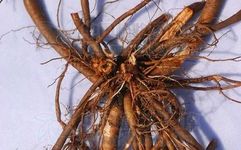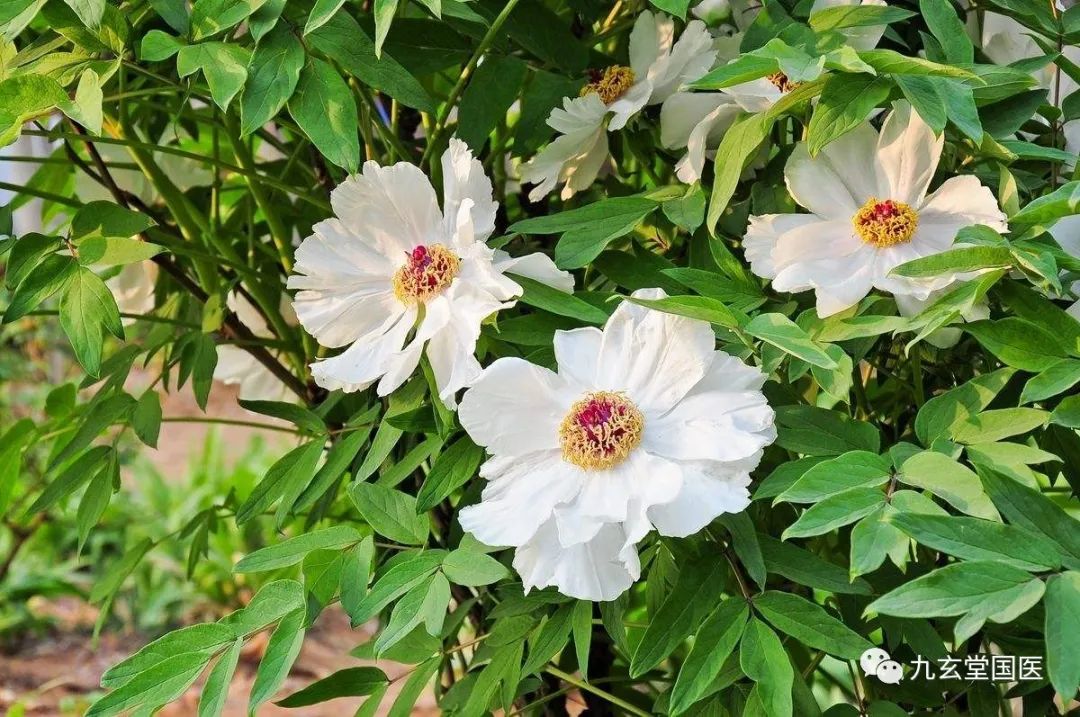
Alias: Jin Shao Yao (Golden Peony) (from “An Qisheng’s Method of Medicinal Preparation”), Bai Shao (White Peony) (from “Pharmaceutical Chemistry”), Shao Yao (Peony).
Historical Production Areas: Central Mountain Valleys and Hills, with the best quality from Bai Shan (Jilin), Jiang Shan (Nanjing, Jiangsu), and Mao Shan (Jiangsu).
Source of Medicinal Material: The root of the plant Paeonia lactiflora, belonging to the Ranunculaceae family.
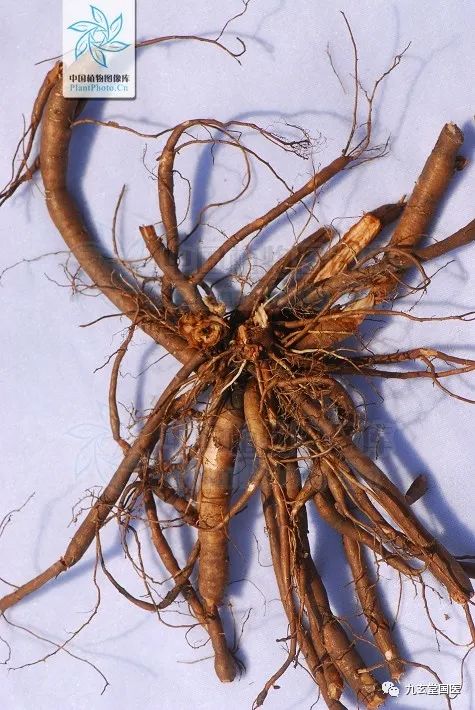
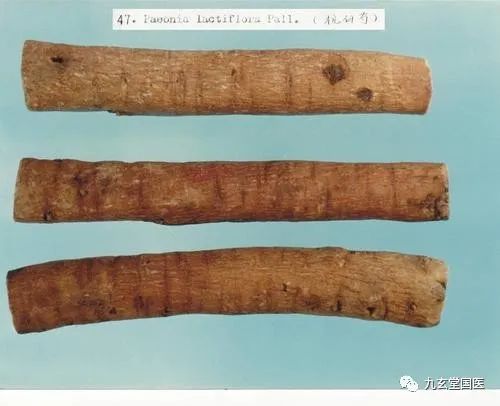
Habitat Distribution: Grows in shrubbery or grasslands on hillsides and in valleys.
Resource Distribution: Mainly produced in Zhejiang, Anhui, Sichuan, etc. Additionally, produced in Shandong, Guizhou, Hunan, Hubei, Gansu, Shaanxi, Henan, Yunnan, etc. The product from Zhejiang is known as Hang Bai Shao, which has the best quality; Anhui’s product is called Bo Bai Shao, which has the largest yield; Sichuan’s product is named Chuan Bai Shao, also known as Zhongjiang Shao, with a large yield.
Harvesting and Processing: Harvest the roots of Peony that have been planted for 3-4 years in summer or autumn, remove the rhizomes and fibrous roots, wash clean, scrape off the rough skin, and briefly boil in boiling water to soften the roots, then dry in the sun.
Cultivation: Prefers a warm and humid climate, is cold-resistant, drought-resistant, and sensitive to waterlogging. It is best cultivated in well-drained, fertile, loose loam or sandy loam with sufficient sunlight. Saline-alkali and waterlogged lands are not suitable for planting. Avoid continuous cropping; it can be rotated with safflower, chrysanthemum, and leguminous crops.
Identification of Characteristics: The root is cylindrical, relatively uniform in thickness, mostly straight, 5-20 cm long, and 1-2.5 cm in diameter. Bo Bai Shao has a powdery white or whitish surface, which is relatively smooth; Hang Bai Shao has a brown or light brown surface, which is rougher, with obvious longitudinal wrinkles and fine root marks. The quality is solid and heavy, not easily broken, with a grayish-white or slightly brown cross-section, horn-like, and the wood part has radial texture. It has a slight aroma and a slightly bitter and sour taste. The best quality is characterized by a thick, long, straight root, smooth skin, solid texture, grayish-white cross-section, high powder content, and no white heart or fracture marks.
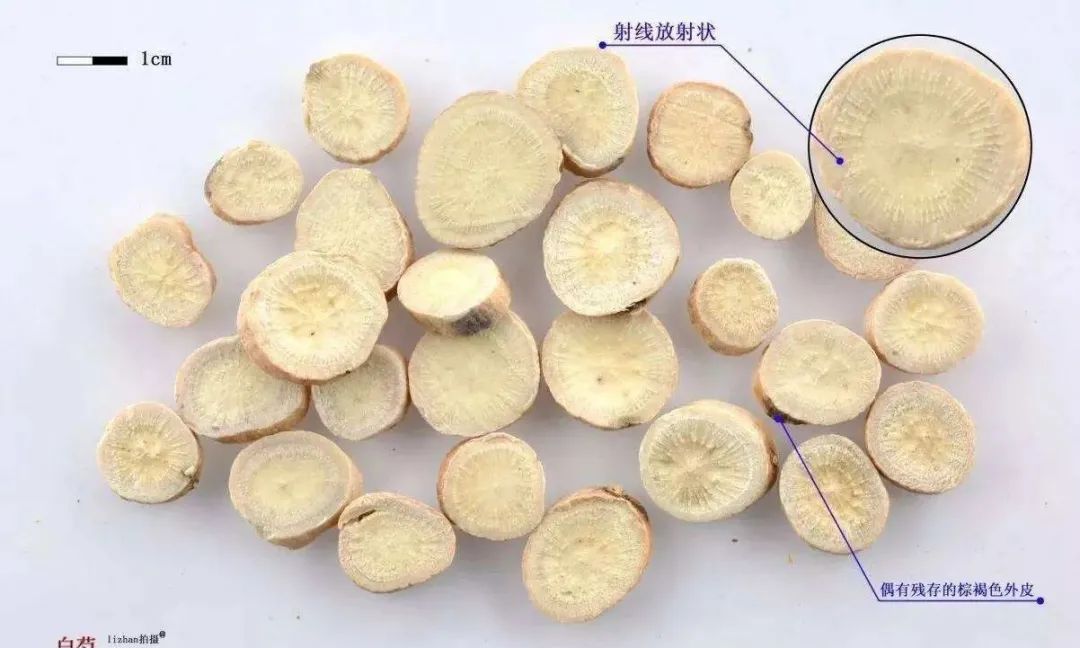
Processing Methods:
1. Clean dust, remove impurities, separate by size, soak in water until 80% translucent, take out, dry in the sun, and moisten until the internal and external moisture is uniform, slice, and dry. In spring and winter, soak in warm water for 4 hours; in summer and autumn, soak in cold water for 2 hours, then drain and place in a jar, cover with a wet cloth, turn daily, moisten thoroughly, take out, slice or shave into 1 mm thick horizontal slices, and dry in the sun or shade.
2. Bai Shao is recorded in “Jin Kui Yao Lue”:“Scrape off the skin.”“Lei Gong’s Theory of Processing”:“Dry in the sun at noon, scrape off the rough skin and the head with a bamboo knife, and grind it.”“Shi Yi De Xiao Fang”:“Remove the reed, chop into pieces.”Currently, take the original medicinal material, remove impurities, separate by size, soak until 60-70% translucent, moisten until fully translucent, slice thinly, and dry.
3. Stir-fried Bai Shao is recorded in “Jing Xiao Chan Bao”: “Stir-fry until yellow.” “Women’s Good Formula”: “Slightly stir-fried.” “Stir-fry until charred yellow.” Currently, take Bai Shao slices, place in a pot, heat over low heat, and stir-fry until the surface is slightly yellow, then take out and cool. Stir-fried Bai Shao has a mild nature, nourishes the liver, harmonizes the spleen, and stops diarrhea.
4. Wine Bai Shao is recorded in “Bian Que Xin Shu”: “Stir-fry with wine.” “Tang Ye Ben Cao”: “Soak in wine.” “Theory of Processing”: “Soak in wine, steam, and slice.” “Ben Cao Chong Yuan”: “Slice, moisten with wine, and cover overnight.” Currently, take Bai Shao slices, spray with yellow wine, mix well, slightly moisten, then place in a pot, heat over low heat, and stir-fry until dry, then take out and cool. For every 100 kg of Bai Shao slices, use 10 kg of yellow wine. The wine processing method is used for menstrual disorders and alleviates abdominal pain due to cold.
5. Vinegar Bai Shao is recorded in “Gang Mu”: “Stir-fry with vinegar.” Currently, take Bai Shao slices, mix with rice vinegar, slightly moisten, then place in a pot, heat over low heat, and stir-fry until dry, then take out and cool. For every 100 kg of Bai Shao slices, use 15 kg of rice vinegar. Vinegar stir-frying is used to restrain blood and stop bleeding.
6. Soil-fried Bai Shao is recorded in “Shi Bing Lun”: “Fried with soil.” Currently, take fine powder of stove heart soil (Fu Long Gan), heat in a pot over medium heat, add Bai Shao slices, and stir-fry until the surface shows a soil color and slightly charred yellow, then take out, sift out the soil powder, and cool. For every 100 kg of Bai Shao slices, use 20 kg of stove heart soil. Soil-fried Bai Shao strengthens the spleen and harmonizes the stomach.
7. Charred Bai Shao is recorded in “Dan Xi Xin Fa”: “Fry until charred.” “Burn to preserve its properties.” “Medical Essentials”: “Calcine to preserve its properties.” Currently, take Bai Shao slices, place in a pot, heat over high heat until charred black, spray with a little water to extinguish the embers, take out, and cool. Charred Bai Shao stops bleeding. Additionally, there are methods for stewing Bai Shao, salt-fried Bai Shao, and bran-fried Bai Shao.
Characteristics of the slices: Bai Shao is thin, round or oval slices, 10-25 mm in diameter, with a whitish or slightly reddish-brown surface, smooth, horn-like, with a whitish center having obvious annular and radial textures. The edges are light reddish-brown or powdery white, with wrinkles. The texture is solid and brittle. It has a slight aroma and a slightly bitter, sour taste. Stir-fried Bai Shao resembles Bai Shao, with a slightly yellow surface, occasionally with yellow spots. Wine Bai Shao resembles Bai Shao, yellowish, with a slight wine aroma. Vinegar Bai Shao resembles Bai Shao, with a slight vinegar aroma. Soil-fried Bai Shao resembles Bai Shao, soil yellow, with a slight charred soil aroma. Charred Bai Shao resembles Bai Shao, with a charred black surface.
Taste and Properties: Bitter, sour, slightly cold.
① “Ben Jing”:“Taste bitter, neutral.”
② “Wu Pu Ben Cao”:“Tong Jun: Sweet, non-toxic. Qi Bo: Salty. Li Shi: Slightly cold. Lei Gong: Sour.”
③ “Bie Lu”:“Sour, neutral, slightly cold, with slight toxicity.”
Meridian Entry: Enters the Liver and Spleen meridians.
① “Pin Hui Jing Yao”:“Acts on the Hand Taiyin and Foot Taiyin meridians.”
② “Ben Cao Jing Shu”:“A medicinal herb that enters the blood of the Hand and Foot Taiyin, affecting the Liver and Spleen.”
Functions and Indications: Nourishes blood, softens the liver, alleviates pain, restrains yin, and stops sweating. Used for chest and abdominal pain, dysentery, abdominal pain, spontaneous sweating, night sweats, yin deficiency with fever, irregular menstruation, metrorrhagia, and leukorrhea.
Precautions: Use with caution in cases of cold abdominal pain and diarrhea. Avoid with Li Lu.
1. “Ben Cao Jing Ji Zhu”: “Must (one version says ‘Lei’) be used with pills. Avoid Shi Hu, Mang Xiao. Avoid Xiao Shi, Bie Jia, Xiao Ji. Avoid Li Lu.”
2. “Ben Cao Jing Shu”: “In cases of cold abdominal pain, cold-induced diarrhea, cold pain in the abdomen, and feeling cold in the intestines and stomach, avoid it.”
3. “Yao Pin Hua Yi”: “Avoid in cases of rashes.”
4. “De Pei Ben Cao”: “For spleen qi deficiency with cold, avoid using in cases of pure blood diarrhea.”
Various Discussions:
① “Ben Jing”: “Mainly for evil qi abdominal pain, removes blood stasis, breaks up hard accumulations, treats cold and heat hernias, stops pain, promotes urination, and benefits qi.”
② “Bie Lu”: “Unblocks blood vessels, alleviates pain, disperses evil blood, expels water qi, benefits the bladder, large and small intestines, reduces swelling, treats seasonal cold and heat, and abdominal pain from evil qi.”
③ “Yao Xing Lun”: “Treats lung evil qi, abdominal pain, blood qi accumulation, unblocks and regulates the viscera, treats evil pain and blood stasis, mainly for seasonal diseases, bone heat, strengthens the five organs, tonifies kidney qi, treats heart and abdominal distension, women’s blood blockage, expels stasis, and can dissolve pus.”
④ “Tang Ben Cao”: “Benefits women’s blood.”
⑤ “Ri Hua Zi Ben Cao”: “Treats wind and nourishes tuberculosis, mainly for all women’s diseases, and various ailments before and after childbirth, regulates menstruation, reduces fever, relieves irritability, benefits qi, treats seasonal heat diseases, pestilence, and mania, women’s blood circulation, intestinal wind, blood in stool, hemorrhoids, and sores, headaches, brightens eyes, red eyes, and pterygium.”
⑥ “Yi Xue Qi Yuan”: “Calms the spleen meridian, treats abdominal pain, collects stomach qi, stops diarrhea, harmonizes blood, consolidates the pores, drains the liver, and tonifies the spleen and stomach.”
⑦ Wang Hao Gu: “Regulates the middle qi, treats spleen deficiency with fullness, heart distension, pain under the ribs, good for belching, lung distension, and cough, nasal bleeding, dry eyes, insufficient liver blood, yang deficiency with cold and heat, and pain in the lower abdomen.”
⑧ “Dian Nan Ben Cao”: “Drains spleen heat, stops abdominal pain, stops diarrhea, collects liver qi reverse pain, regulates and nourishes the heart, liver, and spleen blood, smooths the meridians, and stops liver qi pain.”
Compatibility:
1. Bai Shao combined with Gan Cao (Licorice)
Bai Shao’s sourness restrains and softens, tonifying liver blood and softening the liver, alleviating pain. Gan Cao tonifies the middle and benefits qi, clears heat and detoxifies, alleviating pain. Bai Shao’s sour taste is most pure in wood energy. Gan Cao’s sweet taste is thick in earth energy. The combination of these two herbs harmonizes yin, tonifies blood, softens the liver, and alleviates urgency. Both herbs enter the liver and spleen, softening the liver to strengthen the spleen, alleviating urgency to regulate the middle, making it a specialized remedy for liver conditions. Clinically used to soften the liver, alleviate urgency, and stop pain, both herbs have antispasmodic and analgesic effects, thus can be used to treat spastic urgency. Any urgent pain caused by liver blood deficiency that cannot nourish the tendons and vessels can be treated with these key herbs. Suitable for stomach pain, abdominal pain, calf muscle spasms, tendon knots, limb rigidity, ulcer disease, and acute and chronic gastroenteritis, especially suitable for atrophic gastritis; due to gastric spasms and diaphragm spasms causing vomiting, stubborn vomiting, and neurogenic vomiting, adding these two herbs in the differentiation can significantly improve efficacy; the combination of these two herbs is a specialized remedy for liver conditions, suitable for liver and gallbladder diseases, rib pain, and lower abdominal rigidity pain, all belonging to liver blood deficiency; the two herbs soften the liver and alleviate urgency, showing good efficacy for vascular constrictive headaches; the two herbs alleviate urgency and stop bleeding, Yue Meizhong states, “Bai Shao’s hemostatic effect is miraculous and incomprehensible,” with a clinical dosage of over 30g, indeed having a hemostatic effect; the two herbs harmonize yin, can treat thirst, and soften and nourish, can treat habitual constipation, softening the liver and alleviating urgency can treat painful diarrhea, pharmacological studies show that the two herbs can stimulate gastrointestinal peristalsis and also inhibit gastrointestinal peristalsis; some physicians believe that to nourish liver yin, Bai Shao, Gan Cao, and Mai Ya are the first choices; the ratio of Bai Shao to Gan Cao is best at 3:1 or 4:1.
2. Bai Shao combined with Fang Feng (Siler)
Bai Shao nourishes blood, softens the liver, restrains yin, harmonizes the nutrients, and regulates liver qi. Fang Feng disperses wind, relieves the exterior, overcomes dampness, stops pain, invigorates spleen qi, and disperses liver wind. The two herbs, slightly pungent and warm, combined with slightly bitter and cold, disperse the liver and restrain the liver, and both disperse the exterior and harmonize the nutrients, thus can regulate internally to harmonize the liver and spleen, and also regulate externally to harmonize the nutrients and defenses. Clinically used to harmonize the liver and spleen, treating painful diarrhea and intestinal sounds due to liver-spleen disharmony. It can also be used to treat disharmony of nutrients and defenses, body aches, and limb aches due to insufficient nutrients and blood after childbirth.
3. Bai Shao combined with Gui Zhi (Cinnamon Twig)
Gui Zhi invigorates qi and blood, reaching the defensive qi to harmonize the nutrients and relieve muscle tension. Bai Shao restrains yin and harmonizes the nutrients, regulating liver qi. The combination of these two herbs is appropriate in cold and warmth, restraining and harmonizing, balancing rigidity and softness. It disperses without harming yin, and restrains without obstructing evil. They complement each other, working together to harmonize the nutrients and defenses and balance yin and yang, achieving the function of external regulation and internal supplementation. Clinically used for post-illness or postpartum deficiency with disharmony of nutrients and defenses leading to spontaneous sweating and night sweats; suitable for low fever, sweating, and aversion to wind due to disharmony of nutrients and defenses; suitable for easy susceptibility to colds, allergic rhinitis, and stubborn urticaria due to disharmony of nutrients and defenses; for weak middle qi during pregnancy, abdominal pain around the navel, it is a key herb; for chronic diarrhea, proper application can enhance efficacy. Zhang Lu states, “Shao Yao can drain wood from the earth, it is a must-use herb for diarrhea, but it must be used with Gui Zhi to achieve the intention of restraining while dispersing.” Zhang Bo Yu believes that chronic enteritis of the spleen and stomach deficiency type often has stagnation, using Gui Zhi to warm and unblock, invigorating spleen and stomach function, thus can both support the righteous and expel the evil, and has the meaning of unblocking and using, with efficacy far better than pure warming and tonifying formulas.
4. Bai Shao combined with Fu Xiao Mai (Husked Wheat)
Bai Shao nourishes yin and restrains the nutrients, also able to drain heat. Fu Xiao Mai benefits qi, eliminates deficiency heat, and stops sweating. The combination of these two herbs restrains while the yin and nutrients do not leak out, nourishing so that the yin fluids are moistened, complementing each other, harmonizing the nutrients and yin, restraining sweating, reducing heat, and moistening dryness. Used for labor-induced fever, yin deficiency with low fever, night sweats, spontaneous sweating, restlessness, insomnia, and irritability.
5. Bai Shao combined with Chai Hu (Bupleurum)
Chai Hu excels at dispersing the liver, regulating liver qi, and promoting the smooth flow of qi and blood. Bai Shao tonifies blood, nourishes yin, and softens the liver, effectively treating blood deficiency symptoms. The combination of these two herbs balances rigidity and softness, dispersing without depleting liver yin, and nourishing without obstructing stagnation, making it a good match for regulating and nourishing liver qi. Clinically used for liver qi stagnation, leading to various symptoms both internally and externally, especially for rib pain due to liver qi stagnation, liver-spleen disharmony, liver-stomach disharmony, and liver meridian qi and blood stagnation, making it a key herb; widely used for liver and gallbladder diseases, spleen and stomach disorders, such as chronic hepatitis, cholecystitis, and gastrointestinal diseases; for gynecological issues such as irregular menstruation, low fever during menstruation, dysmenorrhea, breast distension during menstruation, breast lumps, and lower back pain, all belonging to liver qi disharmony or stagnation.
6. Bai Shao combined with Zhi Shi (Bitter Orange)
Zhi Shi breaks qi and regulates qi, guiding the stagnation of the spleen and stomach. Bai Shao nourishes liver blood, softens the liver, and restrains liver qi. The combination of these two herbs promotes unblocking without harming the righteous, and restrains without obstructing stagnation, regulating the liver and the spleen and stomach. Clinically used for liver-spleen disharmony and liver-stomach disharmony.
7. Bai Shao combined with Bai Zhu (Atractylodes) and Huang Qin (Scutellaria)
Bai Zhu tonifies and nourishes the spleen and stomach, generating qi and blood to nourish the fetus, as a healthy spleen can carry the fetus. Huang Qin clears heat and calms the fetus. Pharmacological studies suggest Huang Qin has effects against allergic reactions, thus can calm the fetus. Zhu Dan Xi states, “Huang Qin and Bai Zhu are the holy medicines for calming the fetus.” Bai Shao restrains liver yin and nourishes liver blood, softening the liver and restraining liver qi. The combination of these three herbs tonifies and clears, harmonizing the liver and spleen, inhibiting or interrupting certain immune damage reactions during pregnancy, thus calming the fetal essence.
8. Bai Shao combined with Gou Qi Zi (Goji Berries)
Gou Qi Zi generates essence and nourishes blood. Bai Shao nourishes blood and restrains yin, softening and restraining liver qi. The liver and kidneys share a source, and essence and blood mutually generate. The combination of these two herbs nourishes and restrains, complementing each other, working together to nourish liver and kidney yin blood, softening the liver and harmonizing the liver. Clinically used for blood loss due to liver and kidney essence and blood deficiency, not suitable for products that are excessively cold or hot; Gou Qi Zi is an excellent choice. The combination of these two herbs shows good efficacy for liver and kidney essence and blood deficiency, and for bleeding due to liver not storing blood; also shows good efficacy for dizziness, palpitations, and insomnia due to yin deficiency and yang excess.
9. Bai Shao combined with He Shou Wu (Fo-Ti)
He Shou Wu tonifies the liver and kidneys, benefiting essence and blood. Bai Shao nourishes blood, softens the liver, and harmonizes liver qi. The combination of these two herbs enhances the nourishing effect on liver and kidney blood. With the nourishment of liver and kidney essence and blood, heart blood is also supplied, calming the spirit. Clinically used for liver and kidney deficiency, heart blood deficiency symptoms, such as irritability and insomnia, dizziness, and tinnitus.
10. Bai Shao combined with Dang Gui (Angelica Sinensis)
Bai Shao nourishes blood, softens the liver, and alleviates urgency. Dang Gui tonifies blood, invigorates blood circulation, reduces swelling, and drains pus to relieve pain. The combination of these two herbs nourishes the liver, softens the liver, and balances liver qi to alleviate urgency, harmonizing the middle to promote qi and blood to eliminate stagnation. Clinically used for prolonged diarrhea. For watery diarrhea, it is most unsuitable to use Dang Gui’s slippery nature, while dysentery prefers its slippery nature. Bai Shao’s sour taste enters the liver to pacify wood, preventing wood from invading spleen earth. Dang Gui can protect the intestinal mucosa, while Bai Shao can relieve smooth muscle spasms; if combined with Wu Yao, the efficacy is even better.
11. Others
Bai Shao combined with Gan Cao, Mu Guo (Papaya), Yi Yi Ren (Job’s Tears), and Niu Xi (Achyranthes) shows good efficacy for lower limb muscle rigidity and calf muscle spasms and pain.
Additional Formulas:
1. Sheng Yang Yi Wei Decoction: Huang Qi 60g, Ban Xia, Ren Shen, and Zhi Gan Cao each 30g, Fang Feng, Bai Shao, Qiang Huo, and Du Huo each 15g, Ju Pi 12g, Fu Ling, Ze Xie, Chai Hu, and Bai Zhu each 9g, Huang Lian 6g, Sheng Jiang 5 slices, Da Zao 2 pieces.
2. Bai He Guo Jin Decoction: Shu Di, Sheng Di, and Dang Gui each 9g, Bai Shao and Gan Cao each 3g, Jie Geng and Yuan Shen each 2.4g, Bei Mu, Mai Dong, and Bai He each 1.5g.
3. Zai Zao San: Huang Qi 3g, Ren Shen 3g, Gui Zhi 3g, Bai Shao 3g, Gan Cao 1.5g, Shu Fu Zi 1.5g, Xi Xin 1.5g, Qiang Huo 2g, Fang Feng 2g, Chuan Xiong 1.5g, Wei Sheng Jiang 2 slices, Da Zao 2 pieces.
4. Ma Huang Ren Shen Bai Shao Decoction: Ma Huang 3g, Bai Shao 3g, Huang Qi 3g, Dang Gui 3g, Zhi Gan Cao 3g, Ren Shen 9g, Mai Dong 9g, Gui Zhi 1.5g, Wu Wei Zi 5 pieces.
5. Tong Xie Yao Fang: Chen Pi 45g (two halves), Bai Zhu 90g (three taels), Bai Shao 60g (two taels), Fang Feng 30g (one tael).
6. Fang Feng Tong Sheng San: Fang Feng, Jing Jie, Lian Qiao, Ma Huang, Bo He, Chuan Xiong, Dang Gui, Bai Shao (stir-fried), Bai Zhu, Shan Zhi (stir-fried black), Da Huang (wine steamed), Mang Xiao (each 15g), Huang Qin, Shi Gao, Jie Geng (each 30g), Gan Cao (60g), Hua Shi (90g), add Sheng Jiang and green onion for decoction.
7. Bie Jia Yin Zi: Bie Jia [vinegar roasted], Bai Zhu [soil fried], Huang Qi, Chuan Xiong, Bai Shao [wine fried], Bing Lang, Cao Guo [flour roasted], Hou Po, Chen Pi, Gan Cao in equal parts, with 3 slices of ginger, 1 piece of jujube, and a little Wu Mei for decoction.
8. Si Wu Decoction: Shu Di Huang, Dang Gui (wine soaked and washed), Chuan Xiong, Bai Shao (each equal parts)
9. Ren Shen Yang Ying Decoction: Ren Shen, Bai Zhu, Huang Qi [honey roasted], Gan Cao [roasted], Chen Pi, Gui Xin Dang Gui [wine mixed 3g], Shu Di Huang, Wu Wei Zi [stir-fried and pounded], Fu Ling [70g], Yuan Zhi [50g], Bai Shao [15g], add ginger and jujube for decoction.
10. Huoxue Runzao Shengjin San: Dang Gui, Bai Shao, and Shu Di Huang each 3g, Tian Dong, Mai Dong, and Gua Lou each 2g, Tao Ren and Hong Hua each 1.5g.
11. Sheng Yang San Huo Decoction: Chai Hu 24g, Fang Feng 10g, Sheng Ma, Ge Gen, Qiang Huo, Du Huo, Ren Shen, Bai Shao each 15g, Zhi Gan Cao 9g, Sheng Gan Cao 6g, add ginger and jujube.
12. Gu Jing Wan: Huang Qin (stir-fried), Bai Shao (stir-fried), Gui Jia (roasted) each 60g, Huang Bai 90g, Chuan Gen Pi (stir-fried), Zhi Xiang Fu each 30g.
Jiu Xuan Tang Medical Formulas
1.Ma Huang, Cang Zhu, Bai Zhi, Dang Gui, Bai Shao, Chuan Xiong, Zhi Shi, Ju Pi, Gui Zhi, Jiang, Gan Cao, Fu Ling, Hou Po, Chen Pi, Zhi Ban Xia, Cong Bai, Ge Gen, Huang Qin, Huang Lian. (Jiu Xuan Needle slightly for September maintenance and pericardium meridian maintenance formula)
2. Gui Zhi, Zhi Fu Zi, Chuan Xiong, Ma Huang, Ren Shen, Bai Shao, Xing Ren, Fang Feng, Huang Qin, Mu Fang Ji, Gan Cao, Jing Jie, Hou Po, Chen Pi, Huo Xiang, Chan Tui (Jiu Xuan Needle slightly for spring maintenance, liver disease maintenance and prevention, and conditioning formula)
3. Ren Shen 10g, Dan Shen 10g, Xia Ku Cao 15g, Chuan Xiong 10g, Bai Shao 10g, Ye Ju Hua 5g, decoct for internal use or use a towel to soak in the medicinal juice for hot compress on the navel. (Jiu Xuan Small Needle slightly for dizziness)
4. Dang Gui, Bai Shao, Chuan Xiong, Dan Shen, Chen Pi, Huang Qi, Ren Shen, San Qi, Mai Dong, Fu Ling each 10g, decoct for internal use or use a towel to soak in the medicinal juice for hot compress on the affected area. (Jiu Xuan Small Needle slightly for arrhythmia)
5. Qing Feng Teng 15g, Huang Lian 10g, Sha Ren 10g, Huang Qi 10g, Zhu Ru 15g, Ren Shen 10g, Fu Ling 10g, Chuan Xiong 10g, Jie Geng 10g, Yuan Zhi 10g, Bai Shao 15g, Zhi Wu Wei Zi 10g, Mai Dong 10g, Bai Zi Ren 10g, Gan Cao 10g. Decoct for internal use. (Jiu Xuan Small Needle slightly for heart failure)
6. Ren Shen 10g, Bai Zhu 10g, Rou Gui 10g, Chang Pu 10g, Liang Jiang 10g, Bai Shao 10g, Fu Ling 10g, Zhi Fu Zi 10g, Chuan Xiong 10g, Bai Shao 10g, Gan Cao 10g, decoct for internal use. (Jiu Xuan Small Needle slightly for myocardial infarction)
7. Ren Shen 10g, Bai Zhu 10g, Gan Cao 10g, Fu Ling 10g, Huo Xiang 10g, Mu Xiang 10g, Bai Shao 10g, Zi Su 10g, Chen Pi 10g, Jiang 3 slices, decoct for internal use. (Jiu Xuan Small Needle slightly for obstipation)
8. Dang Gui 10g, Shu Di 10g, Chuan Xiong 10g, Bai Shao 10g, Gou Qi 10g, Bai Mao Gen 15g, Xue Jian Cao 25g, decoct for internal use. (Jiu Xuan Small Needle slightly for anemia)
9. Hong Shen 10g, Jiang Ban Xia 10g, Chai Hu 10g, Huang Qin 10g, Sheng Jiang 5 slices, Da Zao 10 pieces, Gan Cao 10g, Chuan Xiong 10g, Du Huo 10g, Bai Shao 10g, vinegar San Leng 15g, Zhi Shi 10g, Tao Ren 10g, decoct for internal use, one dose daily, two times. (Jiu Xuan Small Needle slightly for no pulse syndrome)
10. Chai Hu 10g, Huang Qin 6g, Ren Shen 10g, Ban Xia 10g, Zhi Gan Cao 6g, Sheng Jiang 3 slices, Da Zao 6 pieces, Dang Gui 6g, Bai Shao 10g, Gui Zhi 10g, Bai Zhu 10g, Zhi Shi 6g, Tao Ren 6g, La Liao 6g, Chuan Xiong 10g, Yi Mu Cao 10g. Decoct for internal use, one dose daily, two times. (Jiu Xuan Small Needle slightly for dysmenorrhea)
11. Chai Hu 10g, Bai Guo 3g, Huo Xiang 15g, Ge Gen 10g, Huang Qin 10g, Yin Chen 10g, Su Geng 10g, Lian Qiao 10g, Yu Zhu 15g, Jin Yin Hua 10g, Gan Cao 10g, Zhi Zi 10g, San Qi 10g, Sheng Di 10g, Xu Chang Qing 10g, Yuan Hu 10g, Mu Xiang 10g, Huang Qi 10g, Bai Shao 10g. Decoct for internal use, one dose daily, two times. (Jiu Xuan Small Needle slightly for chest tightness and shortness of breath)
12. Ren Shen 10g, Bai Zhu 10g, Gan Cao 10g, Dang Gui 10g, Bai Shao 10g, Niu Xi 10g, Du Zhong 10g, Chen Pi 10g, Mu Xiang 10g, Qiang Huo 10g, Mai Dong 15g. Decoct for internal use. (Jiu Xuan Small Needle slightly for atrophy syndrome)
13. Huang Qi 10g, Bai Shao 10g, La Liao 15g, Tie Qian Cai 15g, Lian Qian Cao 10g, Che Qian Cao 10g, Niu Xi 10g, Du Zhong 10g, Nu Zhen Zi 10g, Huo Xiang 10g. Decoct for internal use, one dose daily, two times. (Jiu Xuan Small Needle slightly for prostatitis)
14. Huang Qi 15g, Ren Shen 10g, Bai Zhu 10g, Zhi Gan Cao 8g, Dang Gui 10g, Chen Pi 8g, Sheng Ma 10g, Chai Hu 10g, Sheng Jiang 3 slices, Da Zao 8 pieces, Chuan Xiong 10g, Bai Shao 10g, Yi Mu Cao 10g, Bai Mao Gen 10g, Xiao Ji 10g. Decoct for internal use, one dose daily, two times. (Jiu Xuan Small Needle slightly for metrorrhagia)
15. Huang Qi 15g, Ren Shen 10g, Bai Zhu 10g, Zhi Gan Cao 8g, Dang Gui 10g, Chen Pi 8g, Sheng Ma 10g, Chai Hu 10g, Sheng Jiang 3 slices, Da Zao 8 pieces, Chuan Xiong 10g, Bai Shao 10g, Yi Mu Cao 10g, Bai Mao Gen 10g, Xiao Ji 10g. Decoct for internal use, one dose daily, two times. (Jiu Xuan Small Needle slightly for leukorrhea)

